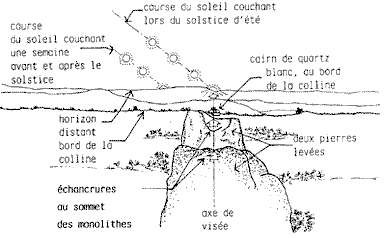 |
Science Frontiers ONLINE No. 73: Jan-Feb 1991 |
|
|
America b.c. and even earlier
The thought that the Atlantic might have been a thoroughfare long before Columbus and the Vikings has been ridiculed by most archeologists for decades. New England megaliths and B. Fell's translations of purported Celtic ogham inscriptions have met only with derision in the professional literature. But times are changing -- at least we hope so.
The Red Paint People. Public TV recently aired a program on North America's Red Paint People, so-called because they added brilliant red iron oxide to their graves. It also seems they knew how to sail the deep ocean, as G.F. Carter now relates.
"Decades ago, Gutorn Gjessing pointed out that the identical [Red Paint] culture was found in Norway. No one paid much attention to that, but more recent carbon-14 dating has shown that the identical cultures had identical dates, and people began to pay more attention. It is now admitted that this is a high latitude culture that obviously sailed the stormy north Atlantic and stretched from northwest Europe over to America. It seemingly extends from along the Atlantic coast of Europe to America and in America from the high latitudes of Labrador down into New York state."The dates are mind-boggling: 7,000 years ago both in Europe and America. That is 2,000 years earlier than the Great Pyramids of Egypt. It is at least 4,000 years earlier than the Mound Builders of the Ohio Valley. The evidence is cummulative, varied in nature, and most probably highly reliable."
(Carter, George F.; "Before Columbus," Ellsworth American, November 23, 1990. Cr. R. Strong.)
 Sketch from Kadath showing how the setting sun, at the summer solstice, lines up with two ancient standing stones and a cairn in western Massachusetts. |
But now European archeologists are beginning to look at these structures. In 1990, the Belgian journal Kadath devoted an entire issue to the subject. This issue comprises 54 pages filled with many photos and drawings of walls, cairns, dolmens, and possible astronom ical sites. We reproduce one of these drawings here, but wish we could provide an English translation of the entire issue. (Anonymous; "Megalithes d'Amerique du Nord," Kadath, no. 72, Spring 1990.)
North American Epigraphy. According to the editor of the Review of Archaeology, D.H. Kelley is "an epigrapher of considerable reputation." And what is the subject of this respected journal and reputable epigrapher? B. Fell's work on North American inscriptions!
Kelley is concerned by the strange lack of supporting archeological evidence at the inscription sites, but as the following quotation demonstrates, he dares to admit an ancient Celtic presence in North America.
"I have no personal doubts that some of the inscriptions which have been reported are genuine Celtic ogham. Despite my occasional harsh criticism of Fell's treatment of individual inscriptions, it should be recognized that without Fell's work there would be no ogham problem to perplex us. We need to ask not only what Fell has done wrong in his epigraphy, but also where we have gone wrong as archaeologists in not recognizing such an extensive European presence in the New World."
(Kelley, David H.; "Proto-Tifinagh and Proto-Ogham in the Americas," Review of Archaeology, 11:1, 1990.)